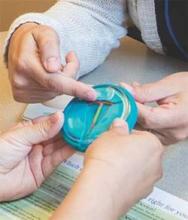SAN FRANCISCO – Few physicians in a recent survey regarding levonorgestrel intrauterine device placement follow the manufacturer’s placement instructions provided on the product insert.
Only 7.5% of 132 respondents said they always perform every recommended placement technique, Dr. Todd R. Jenkins of the University of Alabama at Birmingham (UAB), reported at the annual meeting of the American College of Obstetricians and Gynecologists.
During a brief introduction of the study, Dr. Jenkins, who presented the findings on behalf of his colleague and lead investigator, Dr. Sabrina N. Wyatt, also of UAB, explained that the study was initiated as a result of a system-wide standardization effort.
“We tried to standardize all our residents’ and faculty members’ intrauterine device insertion technique and placement. That resulted in quite the debacle and debate,” he said, adding that a subsequent search of the literature revealed that “there are no studies on the best ways to place an IUD.”
A proposal to conduct a study to determine the best approach to IUD placement was denied by the university’s institutional review board, which deemed such a study unethical because the product insert provides detailed placement instructions.
“So therefore, we decided to survey obstetrician-gynecologists to see how many people actually follow those guidelines,” Dr. Jenkins said.
Members of the Society for Academic Specialists in General Obstetrics and Gynecology and directors of Ryan Residency Training Program were invited to participate. Respondents practiced throughout the United States, and their length of experience ranged from 0-5 years to 21 years or more. Most respondents (81%) were women.
The respondents were divided with respect to premedication of women undergoing IUD placement, with 67% saying they rarely or never premedicate patients, and 33% reporting that they always or frequently premedicate.
Tenaculum use and use of uterine sound for cavity depth were recommended steps eliminated by 30% and 20% of respondents, respectively. Further, 64% of respondents reported eliminating the step of changing from non-sterile to sterile gloves prior to device handling. Few respondents used ultrasound in any capacity, including during, immediately after, or at a later date; 98% said they rarely or never used ultrasound.
No significant relationships were found between the number of years in practice and any of the responses, but there was a significant relationship between practice region and changing into sterile gloves prior to device handling, and having the patient return to the clinic for a string check, the investigators said.
For example, about 70% of those practicing in the Southeast reported changing into sterile gloves, compared with about 20% of those practicing in the Northeast. And about 80% of those practicing in the Midwest reported having patients return for a string check, compared with about 25% of those in the West.
Long-acting reversible contraception (LARC) methods, such as the levonorgestrel IUD, have higher continuation and efficacy rates than do other reversible methods, but barriers to use remain, including cost, patient anticipation of discomfort, and concern for complications, the investigators explained.
Prior studies have demonstrated that variations in practice exist, they said, noting that it is possible that variations and/or reductions in instrumentation could result in decreased discomfort for patients, as well as in decreased time and cost – all of which could increase LARC uptake.
“Our survey confirmed that variations in practice patterns exist among obstetrician-gynecologists in the United States. While some of these variations may be attributed to not practicing in an evidence-based fashion, other variations exist in the absence of evidence,” they wrote, noting that further investigation to determine best practices among these variations is warranted.
Based on the findings of the current study, the UAB’s institutional review board has relented and agreed to allow studies comparing different practice patterns to help determine the most effective and comfortable experience for patients, Dr. Jenkins said.
The researchers reported having no financial disclosures.


